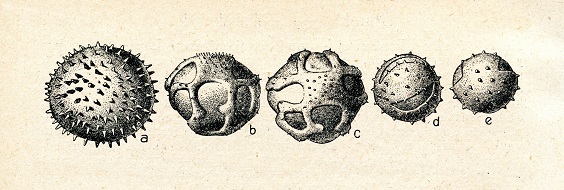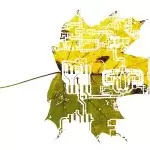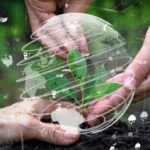
Palynology - the study of micro organic material such as spores, pollen, dinoflagellates and microfossils (1) - is a method employed by a range of disciplines all concerned with the environment. It is not an undergraduate degree subject due to its limited scope, and though there are some Master's programmes in most countries, those wishing to enter into the field may approach the subject from many different directions. They come from botany, plant biology and chemistry, from environmental science, from archaeology, from landscape studies, geography and several other “Earth Sciences” making the method one of the most diverse and broadest of environmental science tools.
One of the most fascinating aspects - and perhaps underappreciated by most people - is how landscapes change over time in terms of the plant life that grows there. We can learn much about the landscape itself, the natural and human history of that landscape (including the changes it has undergone as a result of natural or human processes), and of the changing climate and what impact that has upon plant life. Flora - trees, flowers, grasses, mosses, lichen and even fungi have environmental conditions that they prefer and other conditions in which they will not survive for very long. Moving from a dry to wet climate (or vice versa), from temperate to ice age (or vice versa) and even whether and when a piece of land was once tidal salt marsh but is now pasture, can all affect the makeup of the landscape's flora.
One of the most useful extant remains of a plant that will survive under certain conditions is its pollen or spores. These are the elements of the plant used for sexual reproduction during the spring season. We call this study of pollen and spores pollen analysis. Palynology though, looks at other evidence types that we will cover here (1) such as microscopic marine life, microfossils and other minute organic samples (2).
Pollen and spores do not survive in all conditions all of the time. Though they are hardier than the plants that grow from them, generally we get most of our surviving material (in temperate regions at least) when we dig it up waterlogged soil (3, p2). Some of the best surviving examples of pores and pollen have come from the bottoms of rivers and lakes. They are most common in areas where there is, or once was, a high water table and anaerobic conditions have protected them from the elements. What we know from the study of pollen and spores is dictated by not only conditions, but by virtue of the fact that the sheer weight of numbers during the pollen season leaves us with any evidence at all.
Whether using sexual reproduction, photosynthesis or parasitism, microscopic marine life forms such as plankton are also a major evidence type in palynology. Like pollen and spores, they survive best in waterlogged soils and fossilized samples are best acquired from dried up sea and riverbeds.
A Brief History
Pollen and spores and other microfossils have been subject to study since the advent of naturalism in the mid-17th century; the first credited person to study this type of evidence was Nehemiah Grew, who theorised that pollen was vital to sexual reproduction in plants (4). In fact, Grew was practically the inventor of the science of plant physiology and was one of the most celebrated scientists of the 17th century - and most people today have not heard of him. It was also in the 17th century that the microscope was invented (13); this made the study of this microscopic life much easier and it became the one essential tool in the study of fossilised spores and pollen.
The oil industry is first credited with realising the importance of the wider study of organic inclusions within geological stratigraphic layers (1) - something that had commercial applications for their industry as well as vast academic potential to researchers. It really came to the fore as a science in the early 1900s (3, p2) when a Swedish scientists named Lennart von Post calculated the percentage survival rates of some pollens in peat bogs. Until that point, it was more qualitative than quantitative, making predictions and understanding of survival rate far less mathematical and therefore it was difficult to calculate a population size or density within a given area. The move to a more scientific and quantitative approach made it far more conducive to understanding the science of the Ice Age and how vegetation levels and numbers are affected by the changes in climate. How did certain plant species survive? How did they adapt? How did the vegetation change? Which died out and which thrived? These are just some of the questions that palynologists hoped to answer. Researchers found that in Ice Age Europe, birch and pine were amongst the first tree species to recolonize the soils with pine making an aggressive invasion to replace birch in some areas, meaning rainfall had dropped (3, p3 - see table).
Despite this growth of study, the world “palynology” was not introduced until the end of World War II when the fledgling science of studying tiny organisms was finally given its name. The word “palynology” has been adapted from a Greek word that means “strewn” or “sprinkled”. Thus, palynology is the study of small sprinkled things (5).
The Evidence of Palynology
So what sort of things does palynology look at? All materials used in palynology are referred to as palynomorphs. They are organic materials too small to see with the naked eye (2); anything that is a palynomorph will come under palynology. The scientific definition of palynomorph is “an organic walled microfossil 5 to 500 micrometres in size” (6).
Pollen: This is the most common evidence type and the one that comes immediately to mind when we talk about palynology. First appearing in the fossil record over 300 million years ago (7), their evolution has been a boon for human understanding of the development and colonisation by plant species. During the spring season, a plant that uses pollen for reproduction may use one of two methods to propagate itself.
- Wind: a male part of a plant releases thousands upon thousands of pollen and lets nature take its course by carrying it on the wind until it meets with the female part of another plant. This method requires a lot of energy expenditure on the part of the plant. The air can often be dense with the pollen - hence that so many people suffer with hay fever during the peak of spring. Typically, this type of pollen is light though it has a shell, it will not be as hard or as heavy as the second type. It is also very abundant as the wind will carry it in all directions and lay it evenly around a landscape. Most of the pollen studies in palynology will come from wind-blown pollen
- Insect: Some plants have another route through which to distribute their pollen - using the available animals such as bees, butterflies and other pollinating insects. It doesn't need to blow out tonnes of pollen every day because insects come to it, feed on the nectar, and the pollen gets stuck to their bodies and transferred to another plant when it visits a neighbour. This is often much heavier than wind-blown pollen, and because of the more limited distribution, we have to look in other places (8) for this type of evidence, from the bodies of dead or trapped insects (modern and ancient) or from extant honey residue (9).
Spores: Specific to moss and fungi such as mushrooms and toadstools, these travel the landscape in more or less the same way that wind-blown pollen gets about. This also means that it survives in more or less the same places that wind-blown pollen survives in (10). The walls of the pollen and the spore are remarkably similar so many of the concepts behind the study of each will be the same too. What is likely though, is that spores represent the first method by which marine plant life took hold on land (11). Some may have been distributed through water and took hold in soil as waters retreated (tidal for example). This is still the case for marine plant species that still use spores but like their land-based plant brothers and sisters, they have also evolved to be carried on the wind.
Dinoflagellates: These single cell organisms survive in the ocean. They are quite remarkable and though they serve a different function to pollen and spores (they are a life form in themselves - some reproduce sexually, others asexually, others still through photosynthesis with some that are parasitic) they also fall under the flag of palynology. They live on sunlight and often are the primary food source for most forms of marine life (12) - so abundant are they that at certain times of the year we see ocean blooms; plankton is arguably the best-known type of dinoflagellate.
Applications: What They Can Tell Us
Now that we have established the primary evidence types, we need to look at precisely what it is that palynology can tell us. There is a wealth of information available for many disciples. It's one of the scientific tools for a cross-disciplinary approach to environmental studies.
Geology: We mentioned above that it was the oil industry that first noticed the benefits of palynology as a commercial application for identifying pockets of oil. Certain microfossils survive better in certain types of rock and those that are correlated regularly with oil pockets is a great way of prospecting for new pockets (1); they are abundant in certain types of rock so they act as a great indicator. They may also be used for dating rocks (6); as most of the rocks in which these fossils are found are sedimentary, meaning they were once a river or sea bed - much like how pollen, spores and dinoflagellates survive today.
The Palaeoenvironment: Climate change is largely concerned today with how human activity is changing the environment. In the distant past, climate change was overwhelmingly a natural process subject to all the natural forcings that we know about now and despite that much of the discussion is on anthropogenic climate change, it is important to know the difference as well as understand what factors drive natural processes. In order to understand how we might be affecting the climate, and what effect such elements as greenhouse gases affect the global and local environments, land and sea, we can say with certainty that it is necessary to look to the distant past (6) - periods of cold and warm. How did the changes of the past affect plant and animal life? What were the knock-on effects? Local extinctions? Invasive species? How did the glacial retreat affect the topography and vegetation? For example, we have a good chronology of the retreat of the glaciers in Quebec (14), and how tree species changed as the climate altered.
Geoengineering/geoarchaeology: As well as looking at how natural processes affect the climate, we also use the evidence to look at how human action has changed the topography over time (6). With 250,000 years of human history, there is much about our prehistoric past we still do not know as really only organic material will survive under certain circumstances; therefore the record is limited even though we have learnt so much from what we do have. Palynology has many applications in archaeology, and pollen analysis has been core to tracking the spread of the Neolithic Revolution for example, particularly for selective breeding of plants such as wheat, barley and other grains. In Bohemia, where conditions have been poor in the past, researchers have been able to draw up a 5000 year long vegetation history through pollen studies alone (15).
Human diet: Related to studies of the human environment and geoarchaeology, we now understand many aspects of the day to day living of people who lived in a time where there was no writing. Particularly, we have learnt much from the study of the stomach contents from bodies retrieved from such places as bogs. Stomach contents are often preserved and as the diet would have been largely vegetarian, that organic material we are able to extract from their guts is a vital source of understanding what a typical diet might have been in a certain area (16). It's not just from the bodies either; we also examine human and animal feces and residues from ancient artifacts such as stone tools and pottery (16).
Sources
- http://www.flmnh.ufl.edu/pollen/whatispalynology.htm
- http://www.palynology.org/what-is-palynology
- http://www.bahs.org.uk/AGHR/ARTICLES/05n1a1.pdf
- http://blog.biodiversitylibrary.org/2012/04/book-of-week-birth-of-microscopic-plant.html
- http://www.nhm.ac.uk/research-curation/earth-sciences/micropalaeontology/microfossils/palynomorphs/index.html
- http://www.palynology.org/pollen
- http://www.fastplants.org/pdf/activities/flowering_pollination.pdf
- http://www.bioone.org/doi/abs/10.1080/01916122.2011.629523
- http://www.palynology.org/spores
- http://www.ncbi.nlm.nih.gov/pmc/articles/PMC3220415/
- http://www.ucmp.berkeley.edu/protista/dinoflagellata.html
- http://www.preslia.cz/P051CPok.pdf
- https://www.utexas.edu/courses/denbow/labs/palynology.htm
- Guide to Parasitology - November 19, 2018
- Deserts as Ecosystems and Why They Need Protecting - November 19, 2018
- Conservation: History and Future - September 14, 2018
Related Articles
Featured Article

Geospatial Technology: An Introduction and Overview





